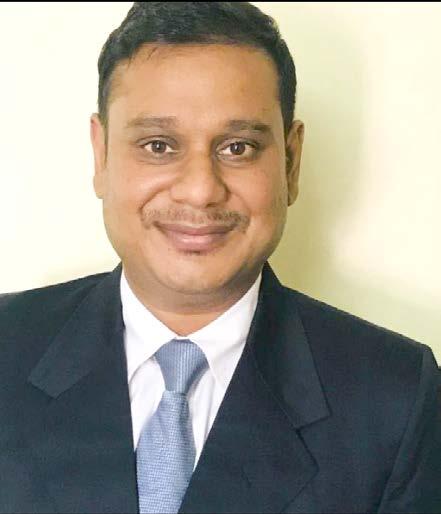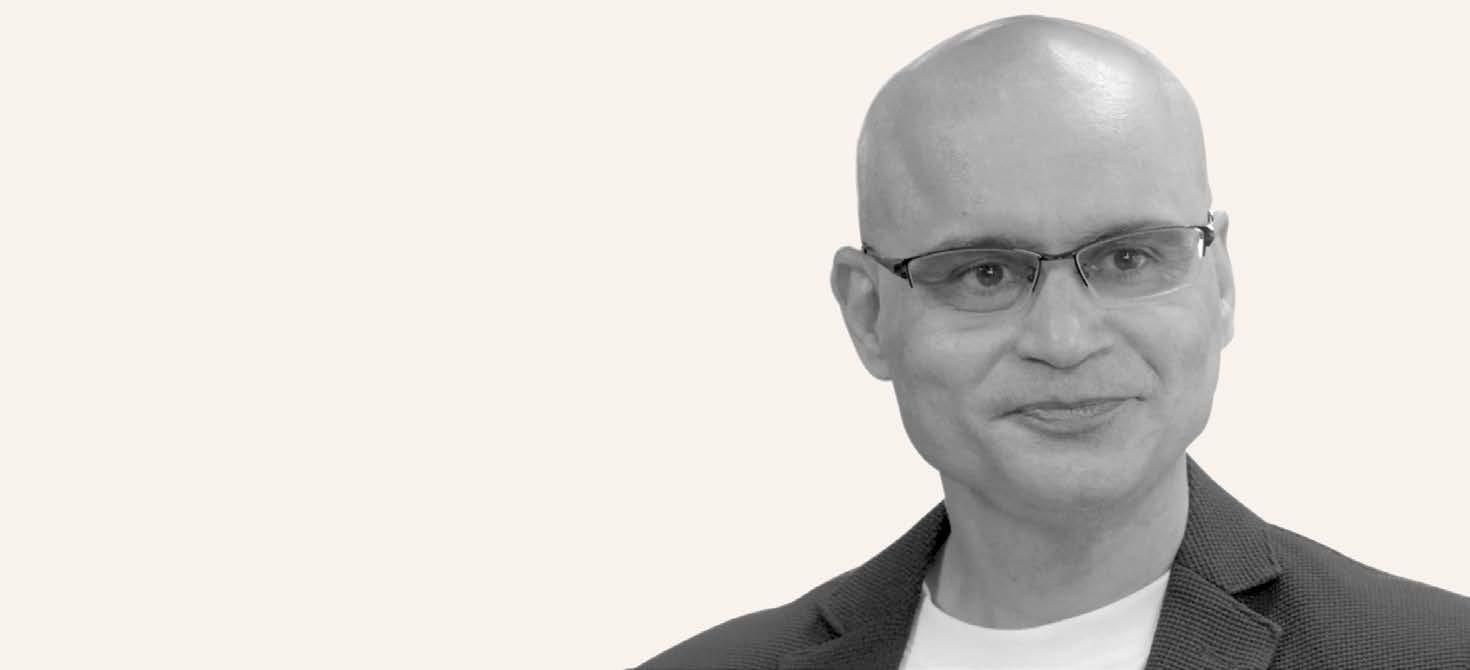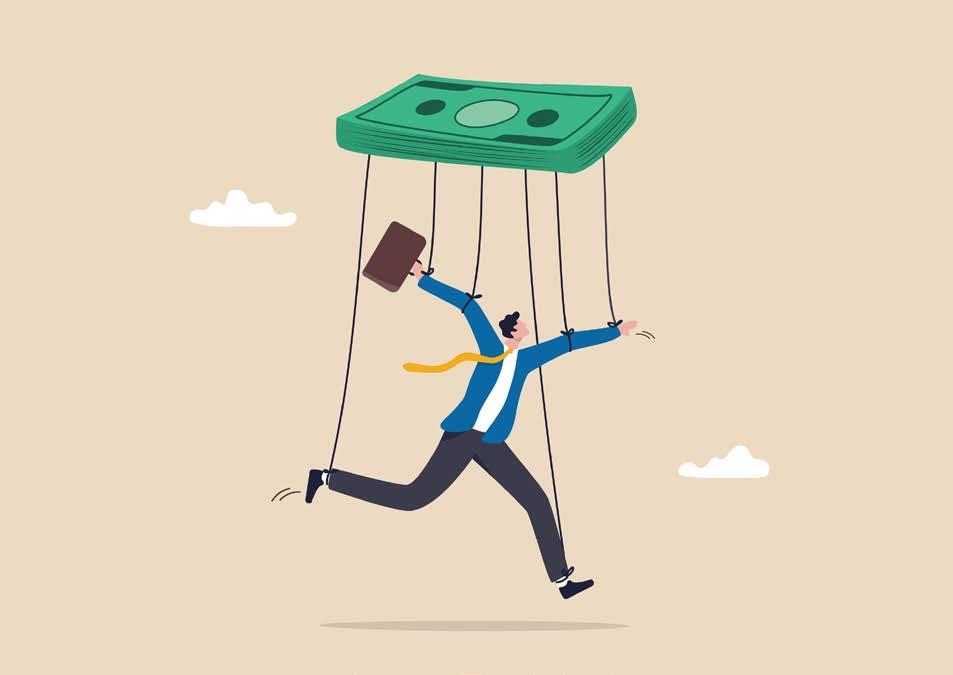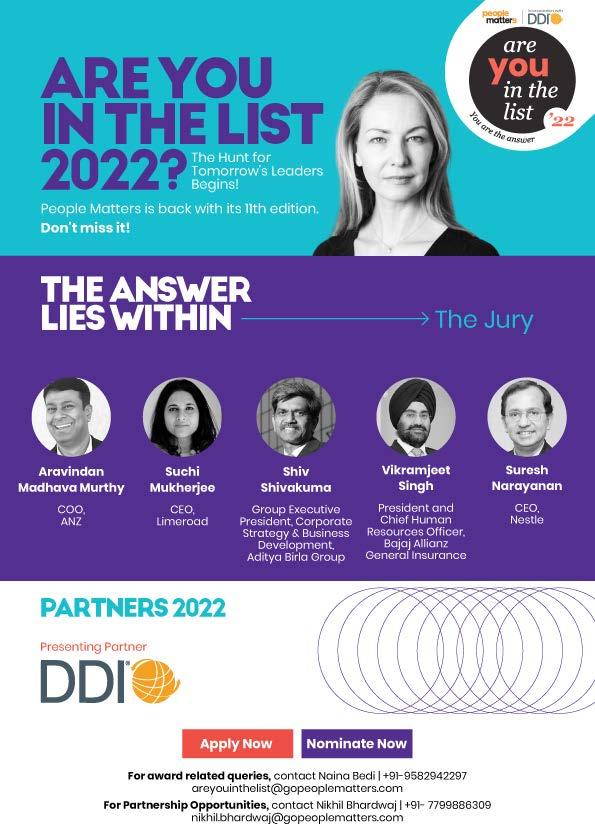
46 minute read
Want better performance? Decouple goals and bonuses
It might sound unintuitive, but in fact pegging compensation to pre-set metrics is counterproductive, says Stuart Robertson, Chief People Officer at AvePoint. He tells People Matters why by Mint Kang
The HR team at SaaS solutions firm AvePoint is done with the old-school performance management approach of bonuses and pre-calculated goals. Instead, they're implementing an OKR framework based on 90-day increments and aligning teams to shared goals at the executive level – turning productivity and performance into a live, moving framework that's much more conducive to teamwork and business agility.
“Today, companies are more interested in setting stretch goals that can yield disruptive growth rather than incremental growth and focusing the performance discussion on enabling this future growth in the context of a team, rather than as individuals,” says Stuart Robertson, AvePoint's Chief People Officer. “With collaboration and diversity being key factors in a thriving workforce, it is impossible to measure one’s performance without the consideration of a broader picture.”
Robertson is not fond of the incremental style that was prevalent just 10 years ago – overly bureaucratic and time-consuming, he calls it, involving thousands of hours of management time and providing little differentiation between actual performance. “Furthermore, it was heavily metric-based, pre-negotiated at the start of the performance year and solely focused on the individual employees’ ability to exceed the targets they had agreed on,” he says.
“Only by decoupling the hard-coded link between goals and bonus payments can we truly set aspirational goals and drive greater performance.”
A better approach to performance in the hybrid model
The need to move away from individual metrics and towards shared, companywide goals is particularly relevant as more and more businesses adopt the hybrid or even fully remote working model, especially for global teams that commu-
nicate almost exclusively remotely. In this model, the whole concept of productivity as we currently perceive it is outdated, Robertson believes:
“Productivity can be ultimately a lagging indicator – Did a person produce effectively and efficiently?” he points out. Instead of focusing on productivity, he thinks companies need to take a more forward-looking approach, one that's about enabling people to do their jobs better in the immediate or longer-term future.
As an example of how this approach can work out, he offers AvePoint's own strategy, which comprises four pillars of empathy, purpose, clarity and technology – and no particular allusion to productivity.
“We focus more on engaging and collaborating with our teams in an open and honest way,” he says. “Firstly, by truly understanding them, their challenges, and their circumstances to meet their needs where they are at. Secondly, to ensure each person understands how their role fits into the overall mission of the company – to enable organisations to collaborate with confidence. Thirdly, to provide clarity on specific

objectives. Fourth, we can employ the full power of our own collaboration technology to communicate, work on things remotely in real time, host meetings that combine groups in a room and remote attendees, and much more.”
If there is a challenge to actually turning these ideals into tangible business performance, it most likely comes from an incomplete view of remote work, Robertson feels.
“People often think about remote work as using ‘hard skills’ and in-person work as using ‘soft skills’. I think this is only part of the picture,” he says.
“Ultimately it comes down to working where, when, and how it makes sense. For years, companies would go offsite if they needed to do strategic planning. This is saying that the office is for more routine work. Today, that has flipped. Routine work can be done, anywhere, and anytime. In-person work is all about collaboration, sharing, planning, team building, bonding, debating, resolving conflict etc.
In other words, performance in the hybrid or fully remote model is about matching the type of work to the appropriate milieu – something that would not even be an option, let alone a consideration, in the 100% on-site model.
The important thing, he adds, is that there is no one size fits all policy – it depends very much on what is needed at a particular time and for a particular purpose, and both individuals and the company have to be open to recognising this and adjusting accordingly.
The supporting factors: upskilling and technology
A few areas are critical to performance management strategies for the hybrid or remote model. One is upskilling, the buzzword of recent years that is more frequently associated with learning digital skills today.
“Teams that focus on and support talent development and upskilling programmes will rise above competition to increase productivity and workforce agility to address dynamic business opportunities,” says Robertson.
And this is not just about 'hard' digital skills as they are commonly conceived, but about the 'soft' skills that allow people to not just use the technology, but use it effectively. It's about recognising the key competencies for a given job, and the capabilities that those competencies involve.
“For example, sales and digital transformation consultancy is a key competency across AvePoint’s global teams. To hone our sales force’s capabilities to engage in compelling discovery conversations with our clients, we have curated a custom course for all of them to learn and practice how to carry effective valuedriven conversations with the modern buyer,” he says.
If the right focus areas have been identified, the outcomes can be clearly measured. In Robertson's example, AvePoint's sales teams have been tracking client response, and 90% of those who took the course have reported more positive client engagement outcomes.
Finally, there's the technology itself, the inescapable fundamental of today's workplace. The bottom line is that technology is what allows a business to adapt to a hybrid or remote-appropriate performance model, he says.
“Through technology, data-powered insights will be driving the evaluation of productivity and performance, especially in a hybrid work environment against a clear set of shared priorities and metrics. Companies that are able to manage and utilise these data insights and effectively create employee engagement, empowerment and development programmes will be best able to adapt well to evaluating productivity and performance remotely.”

Piyush GhosAl
Driving Productivity and Business Metrics through HR Digitisation
Digitalising HR processes is one of the most direct and efficient ways for HR to contribute to workforce productivity. However, this requires careful change management and a focus on how technology impacts users

If there is one major and visible change that the ongoing pandemic has brought, it is the advent of the digital world. From corporate to household, digitisation has established its footprint almost everywhere. Digital workplaces are growing across businesses and the use of technology-enabled solutions is evolving beyond competitive advantage to become a necessity for companies. And this also includes the most important function within any company - the Human Resource function.
Just like any other business function or process, the Human Resource function also needs to be digitised – not as a stand-alone function but as a result of digital metamorphosis of the organisation as a whole.
At the same time, another vital change that the pandemic has brought is that suddenly, enhancing workplace productivity has become the talk of the town – more via gossip and whispers as nobody wants to prioritise productivity over wellness in this pandemic. But alas, businesses cannot survive without being productive and hence, sooner or later, workforce productivity surfaces in the corporate world once more.
The good thing is, business leaders across industries agree that the most strategic productivity hack for any organisation has to be – digital makeover of people processes and Human Resources. Imagine the surge in productivity if HR leaders are equipped with technology enabled solutions to induct, preserve, manage and develop talent.
For example, a user-centric database of people with all relevant information will help businesses in general and HR in specific to make more informed decisions around talent management. Just as in sales, marketing or for that matter any other function, data plays a critical role in helping HR leaders navigate through people – their demography, location, function and all other relevant details. However, HR data is often isolated in different systems and formats, and this lack in coherence of systematically collecting and collating data makes it difficult for HR leaders to connect people strategy with business metrics.

The solution?
Using technology-based data management, digital reporting and dashboard systems to support business in taking decisions in this everdynamic environment.
Introducing chatbots as an interface of communication to employees about HR processes, policies and
systems goes a long way not only to enhance productivity but also employee experience. During the pandemic, HR has frontlined the physical and mental well being of the workforce, to an extent that corporate stalwarts are now considering a new name for HR leaders and that is CWO i.e Chief Wellness Officer. To effectively connect with employees and go beyond business in ensuring a happy workforce, HR folks need to get some bandwidth from the regular operational activities. Introducing AI based chatbots and automating operational HR activities will provide this bandwidth to them which in turn can be used to create a more happy, engaged and productive workforce. Further, employees will also experience a more enhanced technology driven process interface that will help them become less dependent on others for seeking information on organisational processes and policies.
Not only this, automating learning platforms and digitising key courses will create learning conditions that can be embedded into the flow of work. Organisations will be able to sketch out personalised learning solutions specific to teams/individuals or projects making skills and competency development personalised and individual that can fit into everyday routine.
Another area where HR processes can be digitised is company and employee documents. Tracking employee data in paper form, work contracts, appointment letters and other employee documents not only takes a lot of manual processing and large storage areas but also carries a risk of data loss due to paper being perishable. Technology-enabled online data storage can not only help in reducing the physical space required but also minimise the risk of data loss.
When it comes to digitising HR processes, best results come only when an integrated holistic approach is rience. Too much process automation at the same and complex functional usability may result in poor user experience, defeating the very objective of digitisation. When using technology as an enabler, one has to be careful not just to optimise process efficiency but also achieve superior employee experience. Hence involving employees in the decision making, implementation and testing stage, and providing adequate training before final implementation will ensure positive user experience.
adopted wherein the organisation’s current processes and policies are reviewed keeping in mind the future needs, and then it is seen which integrated technology meets the needs. It is important to sketch a roadmap of technical interventions for the entire organisation and include HR as a subset of the organisation. It is important to identify key processes that affect productivity and need to be automated on priority.
Another tip that can be considered while digitising key people processes is to ensure superior user expe-
The recent changes and advancements in enhancing consumer technology have not only surged user experience but also user expectation in terms of faster and efficient delivery. With employees being the internal customers, businesses will have to change outdated systems and processes into technology driven interfaces that satiates the experience of internal customers and helps to drive productivity.
about the author
In an uncertain world, ditch the annual plans for agility

With job openings far outpacing the number of applicants, the future of work today is going to be about how people are working and what employers are doing to build their workforce. sandeep sharma, President – Asia of Workday, shares his perspective
by sudeshna Mitra
Though the pandemic was disruptive, intelligent leadership took this as an opportunity to transform digitally. Sandeep Sharma, President – Asia of Workday, joined an episode of People Matters Podcast to share a general picture of what the ‘future of work’ might look like, speaking from the perspective of a HR tech company that provides people services across several industries globally, and also as a business that itself is working to keep up with the changing world. Here are some excerpts of what he shared.
Recently, a report published by the International Labor Organization states that the employment rate will improve to the standards of the pre-pandemic era, not before 2023. How do you look at this?
It's a very interesting situation and I think all of us understand what's happening in the workplace today, with the disruption and confusion. For the scale of employment to get back to prepandemic levels, 2023 is likely the earliest. But, I don't think the work structure is going to get back to what it was like two years ago. it's going to be a very different sort of work environment. Moving ahead, work is going to be more digitally enabled, more hybrid in nature and more flexible.
So, I think that it is going to be more about how people are working rather than the rate at which they're working. What we have to do is be more empathetic as leaders to ensure that the employees adapt to the new mode of hybrid work on a permanent basis, without hassle. available from the enterprise in the environment, becomes critical. Thus, the opportunity here lies in the fact that enterprises that adopt a new mode of working will see themselves pulling ahead, in terms of business outcomes, employee engagement and employee retention.
We have seen repeated restrictions on international travel due to pandemic and the repeated waves of the COVID-19. What do you see in store for companies working with cross border employees?
This question touches on the point that I made earlier about the future of work and the different work environment. And I think that this should be looked at by the companies as an opportunity. Nobody knows what’s exactly coming next in terms of international travel due to COVID-19. So in this context, enabling employees to work where they are, using the capabilities and the data
Could you please cast some light on the emotional quotient of employees who are hitting the office floors again?
The emotional quotient has gained critical status when it comes to employee well-being. Remote working, residing in containment zones, lack of travelling and socialising, have left a huge impact on our mental health. On the part of the employ-

ers, it has become critical to know what the employees are going through even in their personal lives. Because it is no longer about relying on physical interactions or the ability to see someone – how they react face to face – now it becomes more about intelligent and continuous listening. That process should continue and leaders should be more empathetic to understand the struggles that employees are facing at home and also at work.
I think there's a classic report out by EMI, which talks about empathy in business and about how half of the workers in the US left jobs because their bosses weren't empathetic enough. In fact, if employees are disengaged, it can cost the economy. In the context of the US economy, it costs them half a trillion dollars annually. Having a wide client base globally, we have access to some insights from what our customers are telling us and what we see is almost a quarter of the employees are demonstrating that they are getting ready to make a change.
What is going to be the hiring trend in 2022?
There's no red hot market out there. Just to give you my perspective, I'm based in Singapore and for every 100 applicants for jobs, there are 163 positions advertised just in Singapore.
In Australia, almost 600,000 Australians are expected to be with their new employers in 2022, which is almost 5% of the workforce. That's actually creating scarcity of resources as companies don't have enough applicants. And at the same time, the ones who are qualified have multiple opportunities that they can go after. And so where do employees in this situation end up going? They end up going to employers that have a very good reputation because nowadays that information is democratised. Companies have to transform digitally to ensure that they are attracting the right talent to come on board. And in fact, applicants are looking for that sort of an organisation to join.

I don't believe that there is a way for companies to just hire their way out of this problem. Employers should start thinking about how to create talent instead of just hiring

So, what is the graph of hiring in 2022 going to look like for the HR technology industry?
From Workday's own perspective, our stated goal is to get to revenue 10 billion for the next three odd years. And, we are increasing our headcount by 20% to meet that goal. So in general, I think the tech industry will have similar targets and trends. But I don't believe that there is a way for companies to just hire their way out of this problem.
Employers should start thinking about how to create talent instead of just hiring. And this is where organisations need to transform into skills-based organisations. So leaders need to understand: What skills are needed today, in the future, and how do they flex the organisational capacity to meet the skills needs of the future? As leaders, we need to map the needed skills within the organisation, which is often ignored by many businesses. In fact, in order to increase the longevity of an employee within the organisation, they need to be looked at from the skills perspective.
What is the one big trend from 2021 that may impact the decisions of policymakers in 2022?
In one word, it's agility. There is a generational shift upon us, and the aftershocks are continuing. In this new world, uncertainty is the norm. What has historically worked in the past is absolutely irrelevant. Success in today's world requires us to operate at a much higher metabolic rate. They must play by a new set of rules, they have to see the bigger picture, drive calibration based on data and realise faster cycle times.
In today's environment, you cannot rely on annual plans because you just don't know what's going to happen tomorrow. This is the strategic imperative in front of the tech industry.

REDESIGN JOBS
TO REDUCE WORKPLACE DEPRESSION


by dr Jeffrey Pfeffer & dr M Muneer
Businesses today face an epidemic far worse than COVID-19 – that of workplace stress and depression, which takes an enormous toll on employees and company performance. Various research reports from Gallup to Korn Ferry and WHO have brought out the worrying statistics of workplace “silent killers”: • 18% of reported global depression cases are from India - over 60 million people and multiplying rapidly. • 52% of private sector employ-
ees suffer from extreme stress as a consequence of their work. • 48% of employees are afflicted with mental health issues at work. • Adjusted for population size,
India ranks first in the incidence of mental disorders. • Many employees want to quit but are not able to do so because of financial commitments.
Then there’s depression, which significantly impacts productivity (along with stress, it also leads to absenteeism, presenteeism and turnover), and is one of the leading causes of disability. But that’s not all: Numerous studies show that depression has physiological repercussions and can increase the risk of heart disease, insomnia, weight gain and even cancer.
Last year has seen a renewed focus by employers on the mental and physical health of employees, perhaps as a result of increased stress from WFH and job insecurity. But to make a difference, we need to acknowledge the causes of workplace-induced stress, anxiety and depression: job strain resulting from a combination of high job demands and low job control, long work hours, economic insecurity due to job loss and scheduling uncertainty, low wages that produce economic insecurity, work-family conflict, workplace bullying and harassment, perceived unfairness or a sense of injustice, and a lack of social support.
So how do we go about fixing these issues?
Many of the factors causing stress and burnout can be at least partly remedied if companies stop taking existing jobs and organisational arrangements as sacrosanct and engage in serious redesign initiatives. Here are two examples of businesses doing just that:
Removing Unnecessary Distractions SAS, the largest privately-owned software company in the world, has a 35-hour work week. When we asked their leaders what made it possible, the response was the same: Few people in most organisations work 35 productive hours in a week. (Our independent research across different organisations showed the maximum

number of hours an employee could work productively as six in a day).
SAS took steps to remove burdens that wasted time. On-site childcare, assistance with elder care, a chief medical officer to help choose the best health providers and who provided health plans that didn’t bog people down with paperwork, adoption assistance, and similar benefits reduced distractions by providing employees with highquality help for their life issues.
An emphasis on employee trust and the decentralisation of decision-making also eliminated endless “check-in meetings” and the need to get approval from layers of management – processes that unnecessarily consume much time.
Using Automation to Relieve Burdens The other example is of a company that is redesigning the primary care experience for both patients and providers. To be successful, it needs to reduce physician turnover and burnout (a massive problem within the industry) and to provide an outstanding patient experience by increasing doctors’ level of engagement. Doing so requires addressing a dramatic rise in bureaucratic tasks, too many work hours, and increasing digitisation.
The company is doing something that any organisation can do to reduce the wasted effort that makes long hours necessary and work stressful. We describe it as “user-centred work design.” It takes the same form as “usercentred product design”, more or less pioneered by IDEO. It has become de rigueur and typically includes an almost anthropological observation of people’s product experiences.
The company has rejected offthe-shelf software and hired more than 100 software engineers to build custom systems. The engineers engage with physicians to figure out what tasks can be automated to reduce doctors’ workloads and develop software that is easy to use and helpful. Groups of people from all jobs and levels meet regularly to determine how to allocate work in ways that

reduce stress. This helps the employees figure out what practices, tasks and operations can be eliminated without any adverse consequences.
This Year, Make a Real Commitment to Change
The number of unnecessary work tasks performed in a given day is pretty astounding. Many activities are simply leftovers from long-established policies that no longer serve a purpose. Certain processes, including some owned by human resources, don’t add significant economic value. And many companies take current job designs and work arrangements for granted, thereby foregoing opportunities to seriously reduce workplace stress
We have done many interviews within supposedly leading-edge companies that have embraced a holistic definition of health and well-being, and claimed to understand the connections between health and economic performance. We found that most organisations consider their work environments and habits necessary and never question what they are doing or how they are doing it. For instance, one financial services firm never even considered the idea that its 100 hour work-weeks were neither mandated by law nor useful in attracting or retaining talent.
Job redesign to reduce stress – and increase health and productivity – is not a formulaic activity, which is the major reason why most companies hesitate to attempt it. Just like product design, it requires observation, employee interactions to ascertain how to remove unnecessary tasks and consultation with the people who do the work every day.
Mostly, it requires people who refuse to accept workplace stress and depression as unchangeable and who don’t apply Band-Aids like yoga classes and stress-reduction workshops to see the problem. Any organisation can accomplish this only if it is willing to place employees at the centre of the job redesign process.

about the author
dr JEFFrEy PFEFFEr is Chair Professor of Organisational Behaviour at Stanford Graduate School of Business, and |dr MunEEr is Co-Founder and Chief Evangelist of the non-profit Medici Institute. Twitter@MuneerMuh
Visty BAnAJi
The Dogs of (Office) War
The game of office politics becomes enormously more complicated and lethal when one of the antagonists deploys a pack of underlings. Why is it difficult to counter this tactic and how can organisations reduce its incidence?

When I was a young innocent in the corporate world, I got into a conflict with the head of another department. He was only slightly senior to me in rank but far ahead of me both in age and political savvy. I’d like to believe I got the better of him in the conflict but not without sustaining considerable damage to myself, my team and my progression (at least in the medium term). What I had overlooked was that my antagonist was actually the hit man for a far more powerful player – one who even I would not have been naïve enough to confront at that stage of my career. That oversight caused the first of the several maulings I was to receive by the teeth of the numerous Dogs of Office War (DOW) I encountered over the decades.
A few years later, I had progressed sufficiently to find myself in a face-off directly with the patron of the aforesaid DOW. I was still not a positional match for this 'padrino' but felt I had no choice if I was to guard the organisational value he threatened. Since the 'capo dei capi' had by then given me some signs of public recognition, I thought I had nothing to fear. I was wrong. It is true my 'blue-eyed-boy' status stopped my oversized opponent from confronting me openly or personally. That, however, didn’t prevent him from "ranging for revenge" and letting "slip the dogs of war".1 They picked up numerous seemingly unrelated fights, each of which

could easily be countered but which cumulatively took a heavy toll on my energies, my goal achievements and my reputation for carrying people along in the transformation journey we had begun. The price of tangling with a hunting pack of DOW is not small.
Alert as I was to prevent a recurrence, I found DOW encounters were an occupational hazard for a CHRO seeking to drive change while holding some core values sacrosanct. This has been the experience of other HR leaders trying to make a difference – at least those who have not rolled over in the face of opposition and allowed their bellies to be tickled by powerful satraps or scions. Such struggles are usually neither even nor fair. Yet, every HR professional who has a change programme to fulfil must be able to confront pack attacks and emerge reasonably intact.
Let’s first examine why, even at very senior levels, DOW offensives are serious hazards. Though I have tracked literature on office politics with some assiduity over the years, there is really not much research available on these wolf pack tactics. Bloodily acquired experience will have to suffice as the guide for understanding these infernally effective and invariably pernicious ways in which unscrupulous rivals can sink you or hole your career hull.

With both arms tied and legs shackled
Those who have spent years in the corporate boxing ring and made it to the final rounds have, of necessity, learned to punch back2 – sometimes even above their own weight class. But this is no preparation for facing a full-fledged DOW assault which, obviously, follows no Queensberry rules. One may come out of it alive but rarely unbloodied. No description that I can give of the DOW and their tactics can equal the one given by Kipling about "the dhole, the red huntingdog of the Dekkan… They drive straight through the Jungle, and what they meet they pull down and tear to pieces… and until they are all killed, or till game is scarce, they go forward killing as they go."3 In the case of the DOW, of course, the pack is not autonomous but operating at the behest and under the protection of a practised gamesman. Dealing with them is a Catch-22 prospect.
The instinctive and wholly correct reaction of our (soon-to-be tragic) hero to the first DOW stings is to ignore them. After all, the DOW is usually much junior and it would be unseemly and ungallant to get into a scrap down such a vertiginously steep decline. Intellectually also the firepower of the victim is likely to overshoot the DOW targets. It seems pointless to explain, in nuanced and balanced terms, why the DOW slogans targeted to appeal to the fourth-standard (failed) mind, are too simplistic to solve the complex problem at hand. Very often,

too, when attacks are not launched in the open, even displaying knowledge of their existence can reveal the sources of one’s information. The dialogue can then be hijacked in the totally different direction of punishing people who reveal confidential discussions – while, of course, denying they ever took place.
The matter, unfortunately, doesn’t go away if it’s given the LDB (Let Dogs Bark) treatment. Left unchallenged, the slur, slander or slight continues festering, draining the reputation acquired with years of effort and probity. More immediately threatening is the option available to (and sooner or later exercised by) the prime antagonist to claim publicly that whatever charge the DOW made was established since it wasn’t refuted. Over a period, particularly in HR, the entire function’s credibility comes into question, severely impairing its ability to launch new initiatives or even sustain existing ones.
There is no choice now but to go on the counter-offensive. However, no sooner do the first DOW feel the heat than their patron stands up for them, taking a paternally forgiving attitude and slipping imperceptibly into an adjudicator’s role. This not only makes the attacked party on par with the DOW but a supplicant to the Patronus Maximus (or PatroMax, as we will refer to the ringleader for the rest of this column) who now becomes the judge between the victim and the initial tormentor. While all this is going on, nothing prevents additional DOW from mounting their own sorties. As each such episode reaches its own untidy conclusion (after the initial LDB, the forced attention and the unhappy compromise), the targeted executive is de-energised, depressed and demoralised to the point where normal tasks suffer and reputation deservedly starts getting eroded. The final curtains come down on our tragedy in three acts.
I did not mention the possibility of meeting hireling with hireling i.e. setting up a DOW network of one’s own. This is the ultimate disaster for an organisation. However much each protagonist commits to abjuring first use, DOW networks are expensive to maintain without having the rewards of victory to distribute among the lead DOW. The temptation to launch a preemptive DOW strike is just too great. Thereafter, the entire organisation descends into cabals and coalitions – severely impeding its performance.
The DOW advantage
DOW from the point of the doomed hero. Time to consider why individuals take the trouble to set up a DOW network and, on the other hand, why people subject themselves to such dubious henchmanship. For the time being, we shall ignore the unlikely possibility that the DOW are ideologically committed to a noble management cause or the likelier chance that they get some pathological pleasure out of tormenting others.4
The greatest advantage the PatroMax gains out of having a DOW gang is the leeway it provides for letting them take the extreme positions that s/he desires (but doesn’t publicly own), which can then become mainstream if there is no general condemnation or counterattack by the target. On the other hand, if there is much revulsion or resistance, PatroMax has plausible deniability and a choice of how much to protect or sacrifice the DOW. The abandoning of a couple of DOW, especially those who have far exceeded their briefs and lost their usefulness, cements the generally perceived value of PatroMax as the last bastion of hope against more extreme points of view. Lastly, the fear of DOW ensures the silent majority (and, if pusillanimous enough, even the unit leadership) vocalises its views only when they are supportive, if not effusively admiring, of PatroMax.
The people for whom the game offers maximal ladderclimbing benefit are the surviving DOW, who have played the ophidian role in the snakes and ladders game of corporate politics. There can be unmerited rating improvements and out-ofturn promotions when the DOW are in the reporting hierarchy of the PatroMax.4 Even when they are not, they can be singled out for participation in high-visibility task forces, given additional hats that can be seen which appeals to the need for strong leadership many have in our culture.5
Decreasing DOW Dominance
Taking for granted that some degree of jostling for power is inevitable in any human agglomeration, we will focus on minimising its ill effects in corporates when formations like the DOW make competition unhealthy and unfair. The three best ways of achieving this are lowering the Organisational Political Temperature (OPT), raising the
Importantly, ombudsmen, group headquarters, and independent directors are also valuable nodes to have at the other end of the independent appeal channel
by the top management from afar and get recommended for rapid career progression at inter-collegial committees where PatroMax participates. This last can put the DOW-targeted executive in the unenviable position of losing the loyalty even of formal reports as they believe they owe their rise to PatroMax and hold an eternal grudge against their formal leader if s/he attempts to slow it down. On top of it all, there is the high need for power which most PatroMaxes exude and People Process Robustness (PPR) and installing functioning Channels of Independent Appeal (CIA). I shall illustrate each of these with a real-life example.
As mentioned before, one of my earlier jobs was in a unit that had deep political tows below the surface. Much as I hated being caught up in these dangerous currents, I owe my own political 'nous' to that blooding. In contrast, I also had the joy of working in a very low OPT environment where little energy needed to be
diverted away from organisationally important goals to powering political protection shields. The key difference between the two situations was that in the latter case we had a leader who kept his ear close enough to the ground to be aware of incipient impression managers and nascent DOW groups. Thus, a combination of willingness to spend time on the minutiae of interactions several levels below him, shrewdness to see through the games people play and fairness while nipping conflicts and stratagems in the bud, kept the OPT to double-digit Kelvin at worst. Proof that the leader was the prime reason for the OPT being so low came as soon as he started giving up active control and OPT reached room temperature shortly, with every likelihood of going higher. The size and complexity of the organisation can hugely raise the OPT upper limit and, contrawise, in small arenas even average quality leaders can keep track of political machinations. Incidentally, this is one reason why leaders who have earned their spurs in smaller and simpler enterprises, flounder if they are suddenly catapulted to the upper reaches of global conglomerates. In sum, leadership style sets the dial for the desired OPT and leadership skill determines how far from the leader’s direct sight the setting will actually be effective.
One of my MSME clients who called me in for a detoxification programme (unfortunately, companies can’t be admitted to rehab clinics) was puzzled to find me recommending an overhaul of key HR processes, starting with the Performance Management System. These systems had been installed several years earlier by an HR & Admin Head who had freshly retired from the Army at that time. Fine administrator though he was, he chose to use an Annual Confidential Report (ACR) as the base for most reward and grade progression decisions. Some sincere people chose to play the game by the rules. There were others, however, who found it easier to bump up their ratings by carrying out the behests of their supervisors. If the latter were in a power steeplechase and needed DOW, they enrolled themselves as canine firstclass. An objective targetsetting and open appraisal process with another countercheck on the potential of candidates for significant upgrades took over a year to institutionalize. But the resultant improvement in PPR had an almost immediate effect on OPT and, a short time thereafter, on the rise of the leaders who had made DOW their weapon for destroying rivals.
Before India became an attractive destination for fast-tracked executives in multinationals to build their careers, it was the dumping ground for misfits who were not tolerable in firstworld environments. A CHRO I know closely had the misfortune to get, as

a senior business partner, such a personage. The expat in question not only had a colonial mindset but the attitude that, if he had to put up with local managers in technical domains because he couldn’t do all that work himself, there certainly was no reason to be advised by an Indian on HR. He made it clear, both to his direct reports and others who vied for the expat’s favours, that griping to their 'vertical' heads about the poor local HR support would not be amiss. There were two reasons this master plan came unstuck. First was the professionalism and honesty of the business HR leads who the DOW needed to build the case demanded. Even more vital was the rock-solid support the India CHRO got from the global HR leadership. Rare as it may be for the better-known version of the acronym, this CIA saves the day repeatedly when local recourses are unavailable. Importantly, ombudsmen, group headquarters and independent directors (especially those on nomination and remuneration committees) are also valuable nodes to have at the other end of the independent appeal channel.
Snowball's fall
Many of my idealistic younger readers may find all this political strategising and counter-strategizing repulsively dark and demeaning. Surely logic and organisational interest are sufficient to convince everyone and clear impediments from the path. After all, despite the doubts, many had about the vital windmill project, "… in a moment Snowball's eloquence had carried them away... By the time he had finished speaking, there was no doubt as to which way the vote would go." A clear victory for the rational choice, powerfully presented.
Unfortunately, that’s not the note on which the story ends. At a signal from PatroMax Napoleon, "… there was a terrible baying sound outside, and nine enormous dogs wearing brass-studded collars came bounding into the barn. They dashed straight for Snowball, who only sprang from his place just in time to escape their snapping jaws. In a moment he was out of the door and they were after him… One of them all but closed his jaws on Snowball's tail, but Snowball whisked it free just in time. Then he put on an extra spurt and, with a few inches to spare, slipped through a hole in the hedge and was seen no more."6
Learn from Snowball's fall – don’t imitate it!

Notes:
[1] William Shakespeare, Julius Caesar, Act
III, Scene 1 [2] Visty Banaji, The Faustian Triad, 27 July 2020, (https://www.peoplematters.in/article/life-at-work/the-faustian-triad-26460). [3] Rudyard Kipling, The Jungle Book & The
Second Jungle Book, Wordsworth Classics, 2018. [4] Karen Cacciattolo, Defining Organisational Politics, European Scientific
Journal Special Edition:238, August 2014. [5] Visty Banaji, Music and management, 5
February 2020, (https://www.peoplematters.in/blog/life-at-work/music-andmanagement-24574). [6] George Orwell, Animal Farm, Peacock
Books, 2018.
visTy banaJi is the Founder and CEO of Banner Global Consulting (BGC)
Past Month's events
Workforce Productivity Conference 2022
People Matters BeNext 10 February 2022 Online People Matters Workforce Productivity Conference focuses on how to redefine productivity in a manner that aligns employee expectations with the overarching financial goals - the bottom line of an organisation. L&D Conference APAC 2022
People Matters 24 February 2022 Online This year, the annual People Matters Learning & Development Conference examines the tools and systems that organisations have in place to support the learning and development of their workforce. How do organisations, specifically HR and L&D leaders, balance business needs and development objectives? Talent Analytics: Driving Organisational Impact (English)
People Matters 24 January - 25 February 2022 Online The future of HR lies in analytics. Gain solid knowledge and hands-on practical experience of analytical tools to help in making people decisions. This programme is for HR leaders eager to gain practical, hands-on approaches to talent analytics, connecting HR policies and practices to business performance. Prior knowledge of HR management, statistics and basic managerial accounting is preferred, but not indispensable.
Upcoming events
The HRBP in the New World of Work Well-being: the Road to Resilience Talent Analytics: Driving Organisational Impact (Spanish)
People Matters
BeNext 04 February - 07 March 2022 Online Learn how the HR Business Partner can create greater impact and value with a peoplebased approach to leading the transition to the new world of work. This programme is for leaders and practitioners interested in how the HRBP drives cultural shifts that align with the changing needs of teams and organisations in the new world of work. People Matters
BeNext 21 February - 25 March
2022
Online This programme is for all HR professionals, organisational leaders, and individuals who recognise the importance of actively investing in themselves and in a workplace where mental health, focus, resilience, stress-management and psychological safety are highly valued, and who want to explore and create opportunities to safeguard the well-being of their employees through the implementation of impactful initiatives. People Matters
BeNext 21 February - 21 March
2022
Online The future of HR lies in analytics. Gain solid knowledge and hands-on practical experience of analytical tools to help in making people decisions. This programme is for HR leaders eager to gain practical, hands-on approaches to talent analytics, connecting HR policies and practices to business performance. Prior knowledge of HR management, statistics and basic managerial accounting is preferred, but not indispensable.
Upcoming events
Design Thinking & Agile for HR Teams
Talent Acquisition Conference SEA Women in Leadership: Lead, Influence & Transform
People Matters
BeNext 28 February - 01 April
2022
Online This programme is for HR leaders committed to finding creative solutions to complex problems facing their teams, moving from a foundational understanding of Design Thinking and Agile methodologies to a whole new mindset of creativity, innovation and people-centered progress.
People Matters 24 March 2022 Online How can we tackle the era of the ‘Great Resignation’, the ‘Great Attrition’, and the ‘Great Disconnect’? This conference brings together CHROs, TA Heads, Senior HR & Recruitment leaders to discuss a concrete action plan for improving recruiting processes. People Matters
BeNext 07 March - 08 April
2022
Online This programme is specially designed for women leaders who are interested in accelerating their career growth within their organisation and learning critical skills for women heading a team.
People Matters
BeNext 21 March - 22 April
2022
Online This programme is specially designed for women leaders who are interested in accelerating their career growth within their organisation and learning critical skills for women heading a team. People Matters 08 March 2022 (India), 09 March 2022 (ANZ), 10 March 2022 (SEA) Online This invitation-only, closed door event brings top functional experts and CHROs from their respective regions together to find ways for larger business transformations and chart the path for the future of work and talent.
People Matters
BeNext 28 March 2022 - 29 April 2022 Online This programme is for any HR or Talent Acquisition professionals wishing to establish a more effective understanding of the new business context and hone their employer branding to attract top talent.
Futurist Forum
Digital Transformation & Leading Change (English & Spanish available) Talent Magnet: Aligning
Recruitment, Employer Branding & Business Requirements
Blogosphere >> sri sHivaM

Wakefulness: the new dynamic of leadership
The man of compassion is not unintelligent but he is non-intellectual
blogosphere Decoding Wakefulness
What is the point of thinking when you know? When you know; that becomes part of the very nature of your whole being. Hence thinking becomes a poor substitute when you can understand. When you can know and see what bothers you then who bothers to think? Just awareness is enough! Wakefulness can bridge this gap between knowing and doing and thereby not only create a more wakeful individual but a more wakeful society.
Wakefulness is a daily recurring brain state and state of consciousness in which an individual is conscious and engages in coherent cognitive and behavioural responses to the external world.
Wakefulness is an important tool to see our thoughts, feelings and emotions crystal clear in order to develop a new sense of self-awareness.
In the context of knowing we use IQ, that being a number used to express the apparent relative intelligence of a person. In the context of awareness, we use EQ, that being an individual’s ability to sense, understand and effectively apply the power and acumen of emotions to facilitate higher levels of collaboration and productivity. Emotional intelligence is most often defined as the ability to perceive, use, understand, manage, and handle emotions. Research shows that successful leaders and superior performers have well developed emotional intelligence. This

makes it possible for them to work well with a wide variety of people and to respond effectively to the rapidly changing conditions in the business world. In fact, a person’s emotional intelligence may be a better predictor of performance success than cognitive intelligence.
The emotionally intelligent man is very warm and at the same time doesn't lose his cool
This seems very paradoxical because he is warm, loving and compassionate and at the same time he doesn't get provoked by external criticism and is not driven by emotions, hence doesn't lose his cool!
Society has always conditioned the human mind to be either emotional or intelligent. The modern man needs to be emotional as well as intelligent. This is where the concept of wakefulness assumes importance. When the person is aware and emotionally intelligent due to wakefulness, he is very watchful of his emotions which leads to appropriate actions and responses.
Here’s an example. In a top corporate the boss selected 2 senior leaders and handed over the same project to both of them. One was Mary who was a very happy and emotionally balanced person. Her response to any problem would be very thoughtful and mindful. She was a cheerful and high-spirited person, very life affirmative, flexible and adaptive to new ideas and environment. She had good communication skills and she could express her feelings with others. She used to remain calm in stressful situations by being able to monitor her emotions by being more wakeful. The other was Sam. He always used to be in a stress mode, full of tension and worries. He was a perfectionist. He used to plan everything and tried to control everything. He was cautious while dealing with others but he was moderately motivated. He needed support at work, failed to find the right words to express his emotions.
Who do you think would have cracked the project, Mary or Sam?
Benefits of being Wakeful 1. Empathy: emotional intelligence helps the person to be more empathetic and compassionate towards oneself and others. 2. Collaborative: The person moves from being self-centred to being more inclusive and collaborative. He influences the circle around him and shares his thoughts and ideas which inspires and motivates others. 3. Resolving conflicts inside out:
When emotional intelligence is

enhanced with wakefulness, one is able to resolve the conflicts and manage his emotions. 4. Acceptance is the key: Wakefulness helps us in accepting and acknowledging a given situation, to understand it more deeply and clearly. Once we experience it mindfully, new ways open up to deal with it and we can understand what can be done to make the situation better and find effective and right solutions. 5. Living in the moment: Because of increased awareness due to wakefulness the person is able to be in the moment without unnecessary worry and anxiety
for the future and stress from the past. 6. Focus and Productivity: All the leaders across the globe who have witnessed and learnt this quality in life and who have incorporated this philosophy and concept, have become more focused and productive in their workspace. 7. Unleashing creativity: By being more emotionally intelligent and wakeful, one is able to be more creative and think out of the box and hence it leads to original ideas and new concepts. 8. Transformational leadership: Awakening leadership consciousness is an outcome of an awakened leader who is more mindful and wakeful.
Leaders have led their organisation to exponential growth, but that has always been preceded by their own exponential growth. Connection with mind, body, emotion, and spirit leads to motivation and inspiration. 9. Holistic Well-Being: As per scientific evidence, being more wakeful improves our health, helps in several psychological issues, regulates the autonomic nervous system. A healthy mind leads to a healthy body which helps us to become a better leader.
Tools and techniques for being Wakeful 1. Take a pause: Taking a pause does not mean being passive.
First pause, sit in a calm posture and reflect on the given situation and ask yourself questions regarding what you are doing, what are the problem areas, how it can be solved,etc and listen to your inner voice.
And finally breathe out all your stress, worries and anxieties releasing all the negative emotions and toxins.As we relax and alter our breathing pattern, our mind and body will automatically calm down, which will be a rejuvenating experience.Use your monitoring system of wakefulness accurately to develop this elevated state of consciousness. 2. Being Okay with not being
Okay: Society has always conditioned us to resist our nega-
tive emotions, be it fear, guilt, anxiety and stress and hence we just try to suppress our hidden emotions. But in reality, the emotions stay inside us and just pile up. So if you're not feeling okay, it’s better to observe your emotions and tell yourself that it's okay to not be okay. It's a way to uncover the hidden feelings, to watch and experience oneself properly. 3. Lost vs rediscover: Any routine, if followed for 21 days, becomes a habit, and if done further becomes our very nature. If you are feeling lost, it's time to press the rediscover button! Wakefulness helps you to do that. Practice meditation, observe silence, spend time alone, reflect and introspect.
These practices will refresh your whole system, give clarity, declutter the unwanted thoughts and emotions, clear the mental blockages and eventually help you rediscover your true self. 4. Welcome criticism: When somebody criticises you, stay quiet and observe what is happening at the emotional level. Ask yourself a few reflective questions: a) What the other said to you is true or not: Always welcome the positive criticism. Reflect upon your weaknesses which will help you improve. b) If it is not true then also it is okay: If you're aware or awake you will not react impulsively, will just observe and watch.
You will transform as a leader not only for the organisation but also be able to lead yourself You will transform as a leader not only for the organisation but also be able to lead yourself in a better way. Don't let your emotions lead you, rather you lead your emotions by being more wakeful and alert

in a better way. Don't let your emotions lead you, rather you lead your emotions by being more wakeful and alert.
Imagine you are sitting in a roller coaster but alas, without a seat belt. It would be fatal! Same is the situation in real life. When the emotions which are like a roller coaster make you go through lots of ups and downs, mood swings, panic and depression in different situations in life, you need a seat belt. So, fasten your seat belt of wakefulness and enjoy the roller coaster with the control button in your hands!
about the author
sri sHivaM is an Indian spiritual leader and coach. He is the founder of the non- religious and non-profit organisation, Shivoham Foundation.








